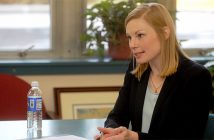
Walk-ins were held across the country last week by teachers, students and community members who carried signs reading “Support Our Schools” and “Actions Speak Louder Than Words” in a push for increased support for public education.
The nationwide rallies were put together by the nonprofit advocacy group Alliance to Reclaim Our Schools. In all, over 900 schools in 30 cities across the United States took part in the events, including Seattle, Miami, Los Angeles and Newark, N.J.
Teachers across the country gathered outside schools about half an hour before work began, many wearing union T-shirts or colors. Parents, school employees, and education activists were also in attendance before walking into the buildings together, reports Samantha Winslow for LaborNotes.
Schools in Seattle used the event to be a symbol of unity between teachers, school communities, and the district as a whole, as their relationship has been strained after teachers and parents participated in a teachers strike last year.
The Washington Senate passed a bill last week discussing the need to find a solution to the way education is funded in the state. The state has previously been held in contempt for not having a way to pay for basic education, and as a result, is being fined $100,000 a day, writes Paige Cornwell for The Seattle Times.
While demands were varied across school districts, the most common issue held was a lack of funding. A report last month from the nonpartisan research organization Center on Budget and Policy Priorities found most states to have not restored education funding to pre-recession levels.
Participants asked for more public libraries, better special education programs, and less standardized testing. One school in the Chicago area made a push for additional teachers, while another in Los Angeles sought an end to the expansion of publicly funded, privately run charter schools.
All of those in attendance were seeking a higher priority to be placed on subjects such as music, dance, theater, and art, as budget cuts are continuing every year across the country for arts programs in public schools. Last November, the Los Angeles Times ranked art programs in schools using data from the LA Unified School District. The paper discovered that only 35 of the 700 schools received an “A” for their arts programs.
Many teachers argue that arts programming is an important aspect of a well-rounded education, adding that relying too much on high-stakes testing has put an end to programs that help students learn to think critically, reports Alex Janin for TakePart.
Researchers at the University of Virginia looked at classrooms in 1998 and again in 2010, finding that classrooms with weekly art instruction decreased by 8%, and 15% for dance instruction. Of the kindergarten teachers surveyed, half of those surveyed in 2010 said that they had not done any theater activities with students in comparison with 18% in 1998.
Protesters at the events walked against the trend seen in schools toward a focus on science, technology, engineering, and math education and away from creative or nonacademic programming. Students and teachers across the country wrote out their visions for how to improve their schools. While art and choir programs were seen to be two of the top requests, one teacher in Pittsburgh wrote simply, “The resources we need to be successful.”
Walk-In Protests Call for More Funding, School Support
0
Share.




